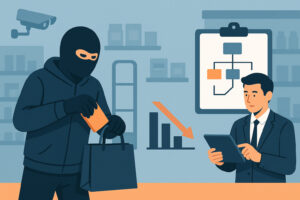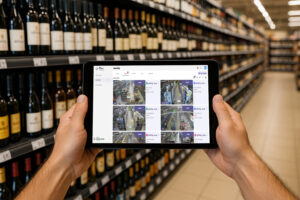Shrinkage: A Constant Challenge for Grocery Retail 🛒
Shrinkage represents the difference between the theoretical stock recorded in computer systems and the physical stock actually on the shelves. This performance indicator is crucial, as it directly impacts the profit margin of stores. While several factors can contribute to it, shoplifting remains the main cause, constituting a considerable and persistent financial loss for the entire retail sector.
To effectively counter this issue, the first fundamental step is to precisely identify the most frequently targeted products. This in-depth knowledge not only allows for the implementation of targeted prevention strategies to reduce losses, but also helps to optimise all in-store operations. By understanding the “hotspots”, it becomes possible to improve stock management and deploy security staff more judiciously and effectively.
Health and Beauty Products: Small, Expensive, and Easy to Conceal 💄
Among the most coveted items, three categories stand out for their high value and their small size, which makes them much easier to conceal. The health and beauty aisles are thus particularly sensitive areas.
-
Cosmetics 💅
Lipsticks, mascaras, and foundations are prime targets due to their compact size and their high resale value .
-
Razor Blades 🪒
Refills from major brands, in particular, represent a significant cost for the consumer and are in high demand, making them a recurring target for thieves.
-
Batteries 🔋
Universal, essential, and relatively expensive, they are very easy to pocket without arousing suspicion.
The main challenge for these aisles lies in the difficulty of monitoring quick and discreet movements, often carried out in very busy aisles where staff attention is diluted.
Focus on the Fresh Food Aisles: Meat and Cheese Top the List 🥩
Although bulkier, certain fresh food products are also highly vulnerable to theft due to their high price . Two product families particularly stand out:
-
Meat 🍖
Premium cuts of beef, such as fillet, ribeye, or sirloin, are among the most stolen items. Their market value makes them a prime target.
-
Cheese 🧀
Speciality cheeses or pre-cut portions from large wheels also represent high value and are regularly stolen.
The theft techniques here are specific. “Ticket switching,” which involves replacing the price tag of an expensive product with that of a cheap item, is a common practice. The impact is then twofold for the store: the direct financial loss of the product and the increased complexity of stock management for perishable goods .
Alcohol and Baby Products: Prime Targets with Diverse Motivations 🍼
Two other high-risk product categories illustrate the diverse motivations behind shoplifting.
-
Alcohol and Spirits 🍾
Bottles of whisky, vodka, or champagne are high-value items, often stolen for resale on parallel markets or for personal consumption. Their popularity makes them a constant target.
-
Baby Formula 🍼
Due to its high cost and essential nature, this item is unfortunately a frequent target, whether out of necessity or to supply a resale network.
Even when these products are equipped with traditional anti-theft devices, they are not foolproof. A complementary human and technological surveillance remains essential to effectively protect these sensitive aisles.
How AI is Transforming the Fight Against Theft in Real Time 🤖
Faced with increasingly sophisticated theft tactics, intelligent video surveillance is emerging as a proactive and highly effective solution . Instead of simply recording images for after-the-fact review, modern systems analyse live video streams. Innovative solutions like Oxania leverage artificial intelligence to go further: they are capable of automatically detecting suspicious gestures , such as concealing a product in a bag, tearing packaging, or lingering in an aisle for an unusually long time.
The operational advantage is immense and transforms security into a preventative approach.
- ✅ Receive alerts in real time directly on a mobile device, allowing for immediate intervention.
- ✅ Enable preventative action , such as approaching the suspected customer to offer assistance—a customer service gesture that is often enough to deter them.
- ✅ Shift from reactive security (identifying a loss) to a proactive strategy that protects margins and improves the environment for honest customers.





